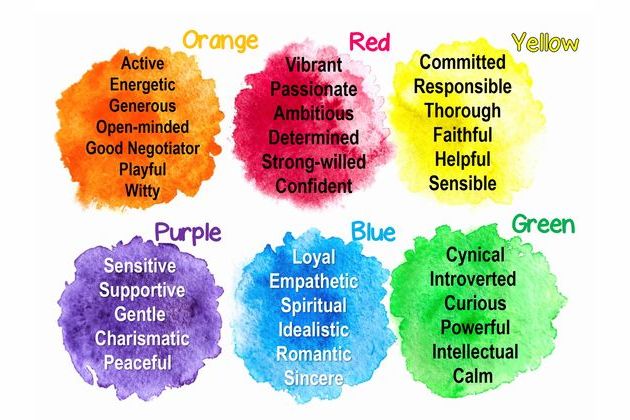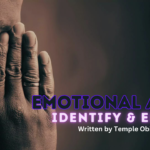Color is all around us, a constant part of our daily lives. Yet, it’s more than just a visual experience—it can have a profound impact on our emotions, behaviors, and even our mental health. Let’s explore the fascinating realm of color psychology and delve into how different colors can influence our mood, well-being, and mental health.
I can’t deny that color does play a role in the outcome of our emotions because i am a direct beneficiary of the energy we draw from colors. I remember University vividly and how certain colors could dictate my moods all day. It wasn’t until my final year that i was able to connect this dot.
“I always believed i could have achieved a lot more if i had stumbled on this point earlier in my life. This is why i am giving it to someone who truly needs it at this stage of their’s” – Temple Obike
One 2020 study that surveyed the emotional associations of 4,598 people from 30 different countries found that people commonly associate certain colors with specific emotions. According to the study results:3
- Black: 51% of respondents associated black with sadness
- White: 43% of people associated white with relief
- Red: 68% associated red with love
- Blue: 35% linked blue to feelings of relief
- Green: 39% linked green to contentment
- Yellow: 52% felt that yellow means joy
- Purple: 25% reported they associated purple with pleasure
- Brown: 36% linked brown to disgust
- Orange: 44% associated orange with joy
- Pink: 50% linked pink with love
The study’s researchers suggested that such results indicated that color-emotion associations appear to have universal qualities. These shared meanings may play an essential role in aiding communication.
Understanding Color Psychology
Color psychology is the study of how colors affect human behavior and emotions. It’s a complex field that explores the psychological, physiological, and cultural aspects of color and its influence on our mental state.
The Emotional Spectrum of Colors
Colors can evoke a wide range of emotions and feelings. Let’s explore some of the most common colors and their emotional associations:
- Red: This color is often associated with passion, energy, and excitement, but it can also trigger feelings of anger and intensity.
- Blue: Blue is known for its calming and soothing qualities. It’s associated with peace, serenity, and trust.
- Green: Green is linked to nature and growth, making it a symbol of renewal, harmony, and balance.
- Yellow: Yellow represents happiness, positivity, and energy, but too much yellow can be overwhelming.
- Orange: This color exudes enthusiasm, creativity, and warmth. It’s often associated with a sense of fun and playfulness.
- Purple: Purple is a color of luxury, creativity, and spirituality. It can also convey a sense of mystery and depth.
- Pink: Pink is often linked to love, tenderness, and compassion. It’s considered a nurturing and comforting color.
- Brown: Brown represents stability and reliability, and it can create a feeling of warmth and security.
- Black: Black is often associated with sophistication and elegance, but it can also symbolize mystery and darkness.
- White: White conveys purity, simplicity, and cleanliness. It can create a sense of freshness and clarity.
The Influence of Color on Mental Health
Our mental health is a delicate balance of emotional, psychological, and physiological factors. Color plays a role in each of these aspects.
Emotional Well-Being
Colors can have a significant impact on our emotional well-being. For example:
- Blue: This calming color can reduce stress and anxiety. It’s often used in healthcare settings to create a sense of tranquility.
- Red: While red can evoke strong emotions, it’s not always positive. It can also lead to increased stress and agitation.
- Yellow: Yellow can boost mood and energy, making it a great choice for spaces where positivity and creativity are encouraged.
- Green: Green is associated with nature and relaxation. It can help reduce stress and promote a sense of well-being.
- Purple: Purple can create a sense of luxury and comfort, making it suitable for environments that aim to provide relaxation and indulgence.
Physiological Effects
Colors can also have a direct impact on our physiological responses. For example:
- Red: This color can raise heart rate and blood pressure, triggering the body’s fight-or-flight response.
- Blue: Blue has the opposite effect, slowing heart rate and reducing blood pressure. It can create a feeling of relaxation.
- Yellow: Yellow is often linked to increased energy levels and can stimulate the nervous system.
- Green: The color green can help with stress reduction and relaxation, contributing to lower blood pressure.
Cultural and Personal Variations
It’s important to note that cultural and personal differences can influence the impact of color. In some cultures, certain colors have specific symbolism or associations that may differ from the general trends discussed here. Additionally, personal experiences and preferences can shape an individual’s response to color.
Other Articles
Navigating Paranoia and Anxiety: Understanding, Comparing, and Empowering Coping Strategies
The Impact of Colors on Hormones and Chemical Activities
The relationship between colors and our mental health goes beyond mere emotions and psychological responses. Colors have a tangible effect on our hormones and chemical activities, which can influence our overall well-being. This segment explores the physiological aspects of color psychology, shedding light on the hormonal and chemical responses triggered by different colors.
**1. The Role of Melatonin: Melatonin is a hormone responsible for regulating sleep-wake cycles. Exposure to natural light during the day and darkness at night helps maintain a healthy melatonin balance. However, the specific wavelengths of light, which correspond to different colors, can impact melatonin production.
- Blue Light: Blue light, often associated with daytime and electronic screens, can suppress melatonin production. Prolonged exposure to blue light, especially in the evening, can interfere with sleep patterns, leading to difficulties falling asleep and maintaining a healthy sleep schedule.
- Red and Warm Colors: On the other hand, warm colors, such as red, have less impact on melatonin suppression. This is why using warmer, dimmer lighting in the evening can promote a restful night’s sleep.
**2. Cortisol and Stress Response: Cortisol is a hormone associated with the body’s stress response. The perception of color can affect cortisol levels, with specific colors leading to increased or decreased stress responses.
- Cool Colors: Cool, calming colors like blue and green have been shown to reduce cortisol levels. These colors can create a sense of relaxation and tranquility, making them beneficial in environments where stress reduction is essential.
- Warm Colors: Warm, intense colors like red and yellow can stimulate cortisol production. In situations where alertness and energy are required, these colors may be strategically used. However, in environments that should promote relaxation, they should be used sparingly.
**3. Serotonin and Mood Enhancement: Serotonin is a neurotransmitter often associated with mood regulation. Colors can impact serotonin production and affect mood and well-being.
- Bright and Vibrant Colors: Bright and vibrant colors, such as yellow and orange, can stimulate serotonin production, leading to improved mood and a sense of happiness. These colors can be used strategically in spaces where a positive and energetic atmosphere is desired.
- Neutral and Soothing Colors: Neutral and soothing colors like gray and soft pastels can have a calming effect, promoting a balanced serotonin level and helping individuals feel more grounded and centered.
**4. Dopamine and Pleasure Response: Dopamine is a neurotransmitter linked to pleasure and reward. Colors can play a role in influencing dopamine production and enhancing our perception of pleasure.
- Rich and Luxurious Colors: Deep and rich colors like purple and gold can trigger dopamine release, creating a sense of luxury, opulence, and pleasure. This is often utilized in branding and marketing to convey a sense of indulgence.
- Natural and Earthy Colors: Natural and earthy colors like green and brown can evoke feelings of contentment and satisfaction, triggering a subtle release of dopamine. These colors can be used in environments where a connection with nature is desired.
**5. Endorphins and Pain Relief: Endorphins are the body’s natural pain relievers and mood enhancers. The visual experience of colors can influence endorphin production, which in turn affects our sense of well-being.
- Bright and Warm Colors: Bright and warm colors, including red and orange, can stimulate the release of endorphins, creating feelings of warmth and positivity. These colors are often used to create inviting and joyful atmospheres.
- Cool and Calm Colors: Cool and calming colors like blue and green can also trigger endorphin release, promoting a sense of relaxation and well-being. They are often utilized in spaces where stress reduction and tranquility are the goals.
The Role of Color in Design and Therapy
Color psychology is widely applied in various fields, from interior design to marketing and even therapy.
Interior Design: Interior designers use color to create specific atmospheres in homes, offices, and public spaces. The selection of colors for walls, furniture, and decor can significantly affect the mood of the space.
Marketing and Branding: Companies use color psychology in branding and marketing to evoke certain emotions and create a strong brand identity. For example, fast-food chains often use red and yellow to stimulate appetite and excitement.
Therapeutic Applications: Color therapy, or chromotherapy, is a holistic healing modality that uses colors to balance energy and enhance well-being. It’s based on the idea that different colors correspond to different energy centers in the body.
Art Therapy: Art therapists use color to help individuals express their emotions and cope with mental health challenges. The act of creating art with specific colors can be therapeutic.
Colors and Mental Health Disorders
Color psychology can also be relevant in understanding and managing certain mental health disorders:
- Seasonal Affective Disorder (SAD): This mood disorder is often associated with the changing seasons, particularly a lack of sunlight during the winter. Bright, warm colors can help mitigate the symptoms of SAD.
- Anxiety Disorders: Anxiety can be exacerbated by certain colors, particularly strong, vibrant ones like red and orange. Cool, calming colors like blue and green can help reduce anxiety.
- Depression: Depressed individuals may be drawn to muted, neutral colors. Encouraging the use of brighter, more energetic colors can help elevate mood.
- Post-Traumatic Stress Disorder (PTSD): Individuals with PTSD may find comfort in soothing colors like blue or pastel shades.
Color Therapy Techniques for Mental Health
Color therapy can be applied to promote mental well-being and manage mental health conditions. Some techniques include:
- Color Concentration: Practicing concentration with a focus on a specific color can promote relaxation and emotional balance.
- Color Breathing: Breathing exercises that involve visualizing or associating breath with colors can help reduce stress and anxiety.
- Color Visualization: Guided visualizations that incorporate colors can be used in therapy to address specific emotional or psychological issues.
- Art Therapy: Creating art using colors that resonate with one’s emotions can be a therapeutic tool in managing mental health challenges.
The Influence of Color in Everyday Life
Colors are an integral part of our daily lives, influencing our emotions, behavior, and mental health. Understanding the psychology of color allows us to make deliberate choices in our environment, whether in our homes, workplaces, or therapeutic settings. By harnessing the power of color psychology, we can create spaces and experiences that support our emotional well-being and mental health, ultimately enhancing our overall quality of life.



1 Comment
Kandace
This article is everything I’ve been saying to others but not so detailed like the article itself. I suffer from mental health but although I may be feeling down, depressed, and overly stressed. I make it a plan if to wear some kind of color clothing. People are attracted to color whether they know it or not. Color also makes people happy.